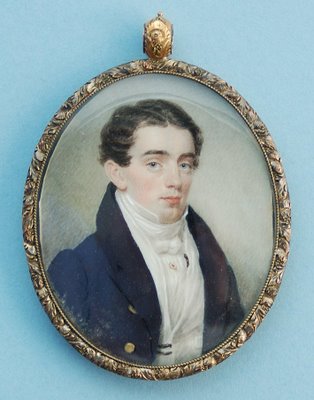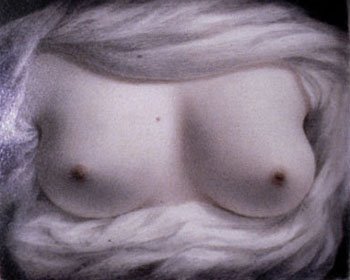
Sarah Goodridge (1788-1853) was born in a small village in Massachussetts, the sixth of nine children. Growing up in the country, she learned to draw by scratching pictures with a pin on birch bark. Eventually she made her way to Boston where she earned a living painting miniature portraits on ivory.

In the days before photography, such pictures were often worn in lockets or pinned to lapels.

Goodridge's miniatures were very popular and she soon flourished as an independent artist-- a rarity for a woman in colonial America. By painting two or three portraits a week, she made enough to support her sick mother, her orphan niece, and other family members. Her career lasted for thirty years until her failing eyesight forced her to stop. She never married.
Goodridge did, however, develop a special friendship with the handsome young Boston lawyer Daniel Webster. The first time she painted Webster's portrait, he was married with three children. He sat for eleven more portraits over the next 25 years. Webster and Goodridge wrote each other frequently; she carefully preserved letters from him, while he seems to have carefully destroyed letters from her. When he moved to Washington to serve in government she visited him there twice.
After Webster's wife died in 1827, Goodridge secretly painted this miniature for him entitled Beauty Revealed (self portrait):

Sarah's daring self-exposure was unthinkable in an era when modesty was rigidly preserved by several layers of clothing. Her painting crossed all kinds of boundaries-- social, sexual, religious, artistic and economic. John Updike describes this little jewel as "the first known nude American portrait done from life" that has survived.

No one can ever be certain what Webster and Goodridge shared in private. Scholars have agreed that at a minimum, Goodridge's poignant self-portrait communicates her availability to Webster (or, as Updike wrote, "we are yours for the taking.")
Could an object so small ever carry greater weight? Sarah's offering is not mere pigment on ivory. It shows how an artist invests a physical object with deep significance, and through that object reaches out to another human being. It reminds me of Walt Whitman's impassioned attempt to use a poem to reach beyond his mortality and touch some future reader who might be holding Leaves of Grass late at night:
Now lift me close to your face till I whisper,Whatever their private relationship, Webster was politically ambitious and needed money, so Goodridge simply would not do for his second wife. He met and promptly married another woman, whose sole qualification seemed to be that she was from a wealthy and prominent family.
What you are holding is in reality no book,
nor part of a book;
It is a man, flush'd and full-blooded -- it is I -- So long!
We must separate awhile --
Here! take from my lips this kiss;
Whoever you are, I give it especially to you;
When Goodridge died, she left Webster her beloved paint box.
As for Webster, he kept her tiny painting hidden amongst his personal effects until the day he died. It was discovered by his heirs and was eventually sold off. This miraculous glimpse of a beating heart beneath the manners and undergarments of an earlier generation is now safely contained in an antiseptic museum showcase.






